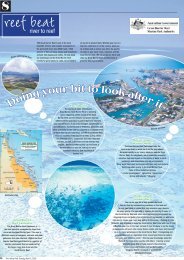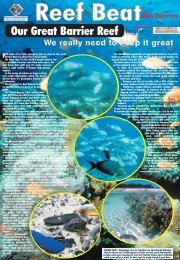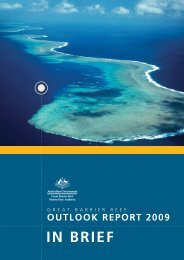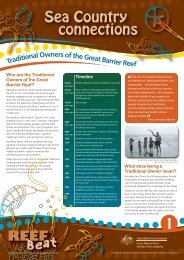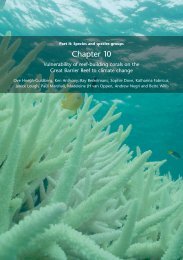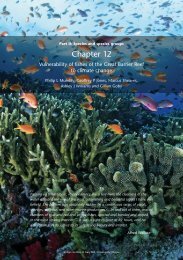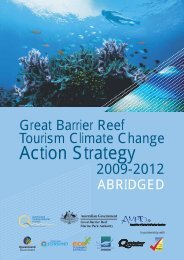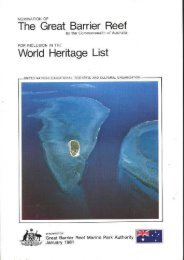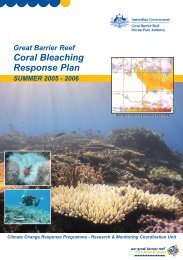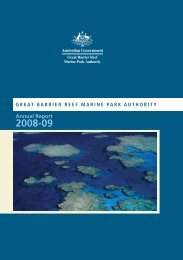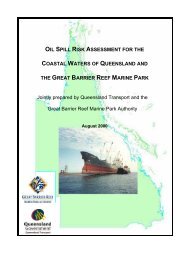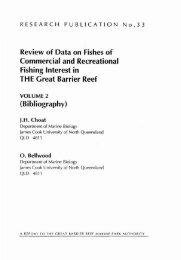ACTIVITIES BOOK - Great Barrier Reef Marine Park Authority
ACTIVITIES BOOK - Great Barrier Reef Marine Park Authority
ACTIVITIES BOOK - Great Barrier Reef Marine Park Authority
You also want an ePaper? Increase the reach of your titles
YUMPU automatically turns print PDFs into web optimized ePapers that Google loves.
to recognise them when they get there.• Ask students to draw up a table (such as the one below) to record information about the birds.Date Location Habitat type Main type of Birds present Human impacts(e.g. wetland) trees/shrubs (e.g. weeds/rubbish)• Next, students collect observations of birds. They may wish to visit the area at different times of day tosee if results vary.• Ask students to create an inventory of local birds. As a class, you may like to create a birdidentification book for your local area.• Once students have compiled a local bird list, they can develop a local bird management plan. Theplan should include information about local birds including where they are found, interesting facts,migration patterns (if a migratory species) and ideas about what the local community can do to helpprotect them.• As a follow up activity, students could investigate which species ofnative trees will attract new birds to your school grounds. You couldwork with your local land care group, council, natural resourcemanagement agency or bird watching group to hold a tree plantingday at school to attract birds to the area.Discussion: Conclude this activity with a discussion of the pressuresfacing local birds. Extend the discussion to include consideration of climatechange impacts and how these will affect local birds. Ask students to thinkabout how the local ecosystem would change with the removal of birds.Activity 2: Development of species survival planKey learning objective: In this activity students will learn how global processes such as oceancirculation, distribution of fish stocks and sea bird survival are intrinsically linked. By investigatingclimate impacts on a global scale, students will understand theneed for a world wide solution to climate change.Background: Cold water from the bottom of the ocean(where no sunlight can reach it to warm it up) and fromthe Earth’s poles is carried towards land by oceancurrents. These waters are full of nutrients and manyimportant and valuable fish species can be found inthese areas. A good example of this is off the coast ofPeru in South America where cold water from the deepocean is pushed to the surface by ocean currents. Thesewaters support millions and million of small fish. Thesmall fish are eaten by bigger fish, sea birds, and othermarine life. The bigger fish are eaten by sharks and other large predators. Thusthe nutrient-rich waters are the basis for this food chain.Bright idea:Discarded fishing line,hooks, plastic bags,bait, rags and otherfishing related litter cankill sea birds. Hold a responsiblefishing day to raise awarenessabout responsible fishing practicesincluding rubbish disposal. It’s funtoo!Seasonal shifts in ocean current patterns (like El Niño events) mean that fish and other creaturesthat rely on upwelling of nutrient rich waters, must move to follow their food supply. Similarly,migratory birds move to follow the large fish stocks they rely on for food. Because migratory birdsare affected by climate and environmental changes on a global scale, protecting these speciesrequires world wide solutions.To understand how seabirds will be impacted by climate change, students need to understand howthe climate phenomena of El Niño and La Niña work.El Niño and La NiñaEl Niño and La Niña are major temperature fluctuations in the Pacific Ocean. They are oppositephases of the El Niño-Southern Oscillation, which is like a giant ‘see-saw’ of the world’s weather.23<strong>Reef</strong> Beat 2009 - Climate Change and the <strong>Reef</strong>



